- Offensive Techniques & Strategies
Disrupting Double Screens
Double screens can be a real problem for any team that is not prepared to defend them especially since teams like to run them in last shot situations. Double screens can be set parallel or perpendicular to the baseline or in a staggered fashion. To properly disrupt double screens it takes a coordinated team effort. The player guarding the receiver must execute a V-Step to get over the screen. The defender guarding the screener closest to the passer must step out (show) while the defender guarding the screener furthest from passer must drop off and zone. Pressuring the passer also plays a key role in the success of disrupting double screens.
Communication
Since a double screen involves four players if you count the player guarding the ball handler, so communication is a must. When the opponents form a double screen alignment, a verbal call should be yelled out such as "Double"-"Double" to trigger and coordinate the defensive (drop off, step out and V-Step) actions.
| Free Throw Line Double | Baseline Double | Stagger Double Screen |

Double Screen (Free Throw Line)
Chase Out "V-Step" Technique
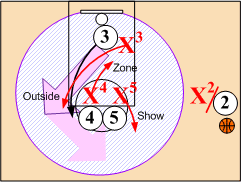
Defender X3 chases O3 over double screen, moving to the outside shoulder to get over the screen. Defender X5 steps out and shows while defender X4 drops off and zones.
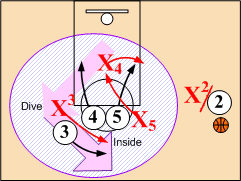
Once over the screen, X3 quickly dives back to an inside of O3 assuming a strong, pass denial position completing the V-Step. Defender X4 picks up the first cutter to the basket O5, and X5 drops to a low Helpside I position on O4.
Jump Switching Alternative
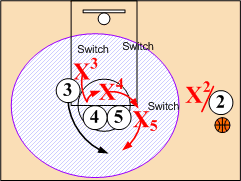
Switching against a double screen requires three simultaneous switches. This takes a lot of communication and practice. The real problem of switching resides in the fact that the primary receiver is breaking out from behind and out of the vision of the two defenders guarding the screeners.

Double Screen (Baseline)
Chase Out "V-Step" Technique
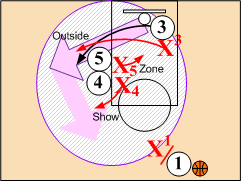
Defender X3 chases O3 over double screen, moving to the outside shoulder to get over the screen. Defender X4 steps out and shows while defender X5 drops off and zones.
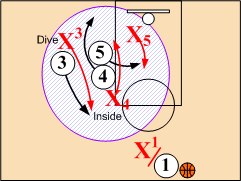
Once over the screen, X3 quickly dives back to an inside of O3 assuming a strong, pass denial position completing the V-Step. Defender X5 picks up the first cutter to the basket O5, and X4 drops and assumes a low post pass denial position on O4.
Jump Switching Alternative
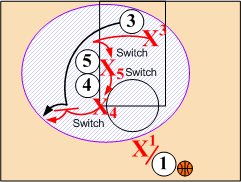
Switching against a double screen can be done. However, since it requires three simultaneous switches, it takes a lot of communication and practice. The problem on switching does not lie in denying the primary receiver the ball, but rather, in defending the screeners breaking the double screen and cutting to the basket.

Stagger Double Screen
Staggered Double Screens are primarily used to free up great shooters. Therefore, defenders must anticipate and be prepared to defend them.
Prevention
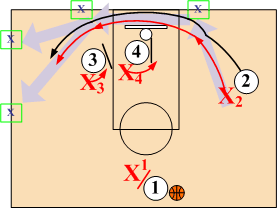
The stagger double screen action can be eliminated simply by the defender forcing the cutter to the baseline pushpoints. When successful, this forces the cutter away from the screeners.
Learn More: Defending Back Cuts
Chase Out "V-Step" Technique

Phase 1. Defenders X3 and X4 assume pass denial positions on screeners O3 and O4. On O2's back-cut, defender X2 rides O2 to baseline pushpoint maintaining a pass denial shoulder to shoulder drop. Crossing under the basket, X2 switches "Stop Signs" with a quick head snap and moves to O2's outside shoulder in order to get over O3's down screen. Defender X1 pressures the passer forcing O1 to sideline pushpoint.
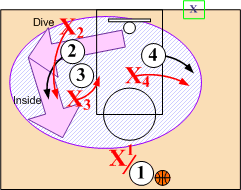
Phase 2. After getting past O3's down screen, X2 quickly dives back to a strong inside pass denial position on O2. X3 and X4 maintain pass denial positions.
Jump Switching Alternative
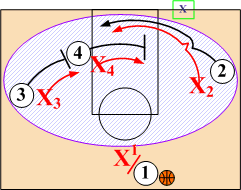
O1 pressures the passer and forcing to sideline pushpoint while X3 and X4 assume pass denial positions on screeners' O3 and O4. Defender X2 denies O2's back-cut by maintaining a strong pass denial position and forcing O2 toward baseline pushpoint out. X2 moves to O2's outside shoulder in order to get passed O4's base screen.
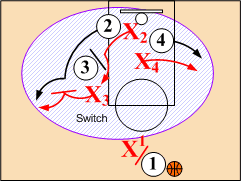
After getting past O4's base screen, X2 and X3 execute an aggressive jump switch with X3 quickly switching out to O2 assuming a strong pass denial position. Defender X2 then steps over O3 and assumes a strong low post pass denial position.
© 2026 HoopTactics All Rights Reserved.
